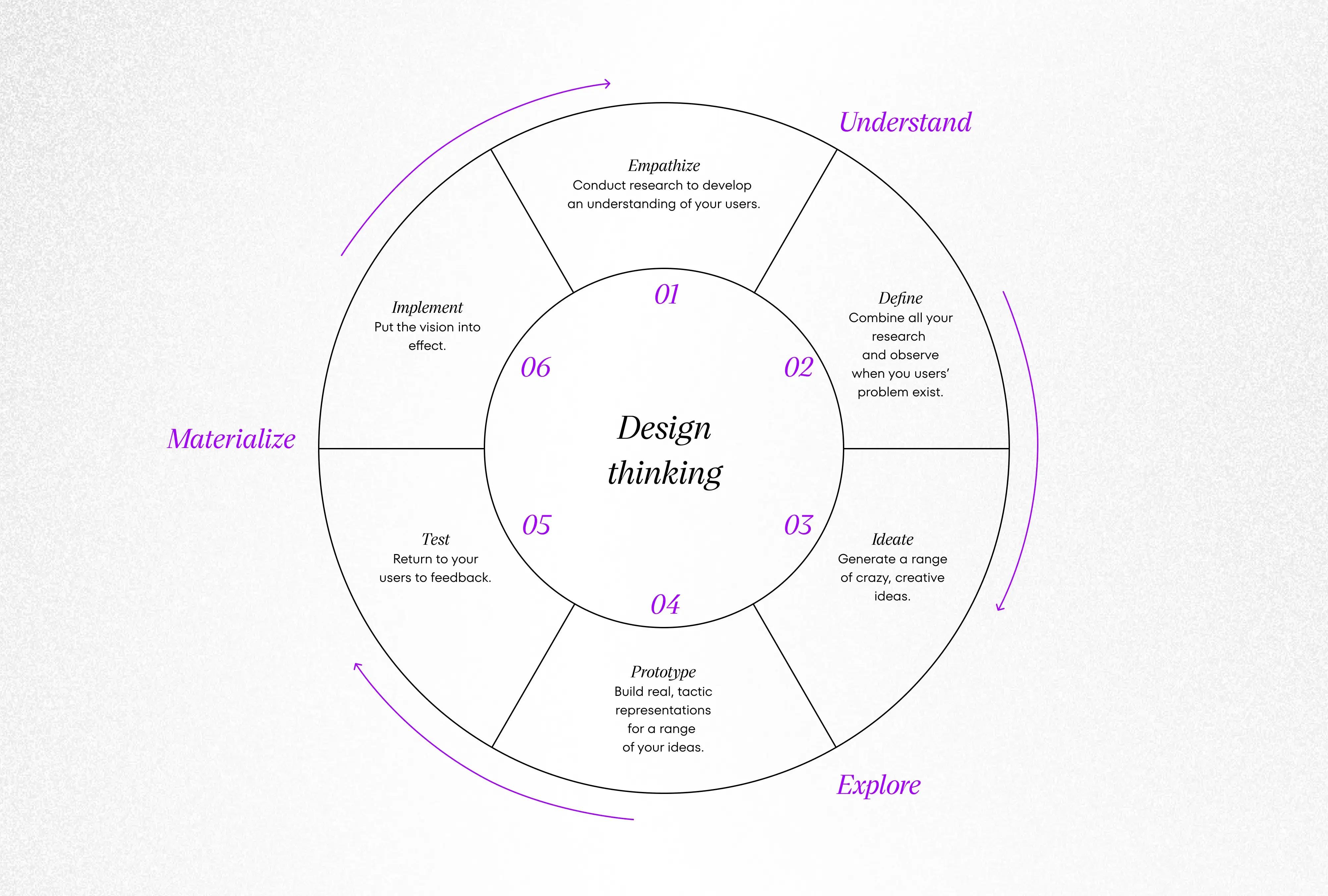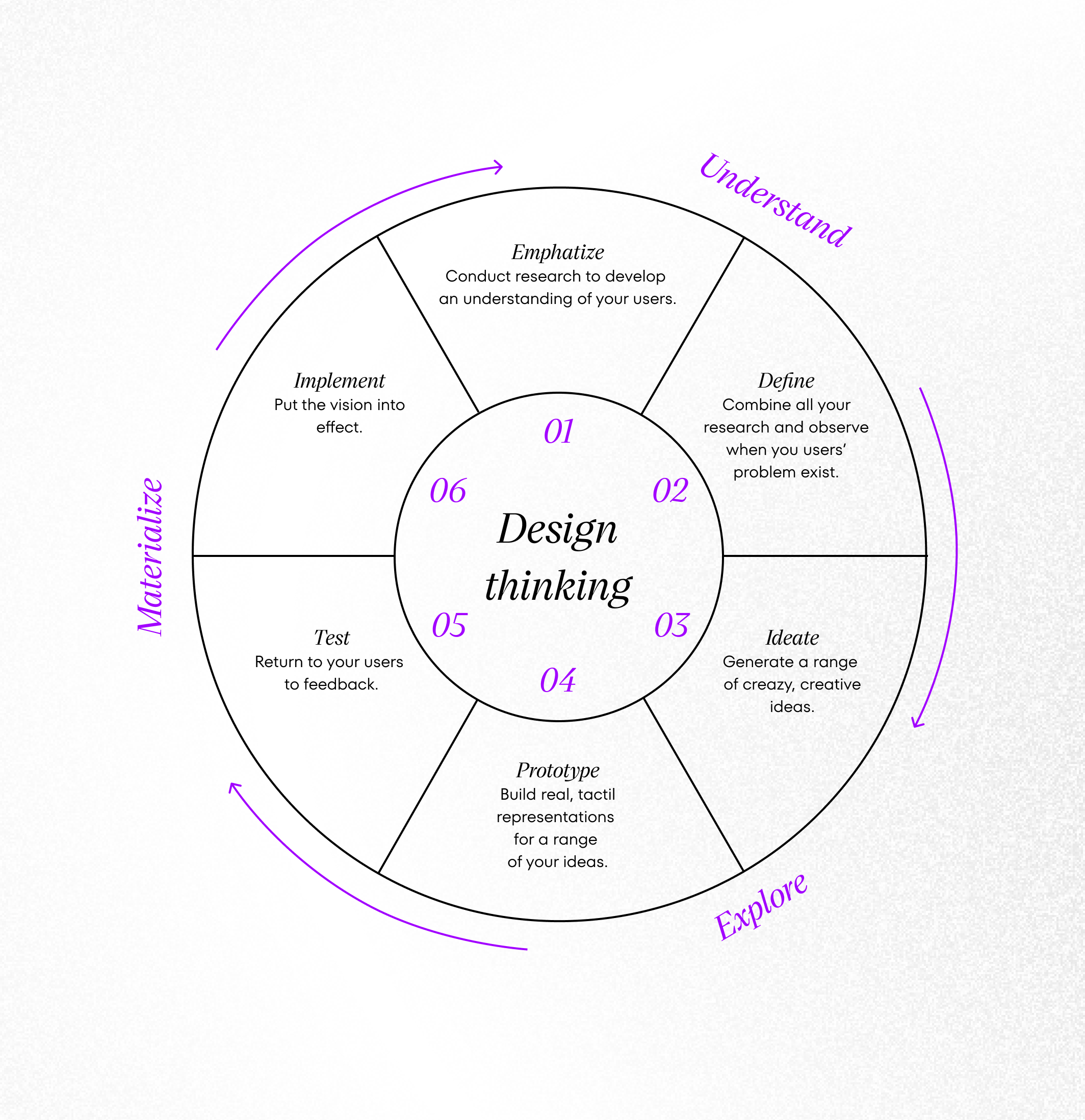August 20th, 2019 | by Radosław Szmit
How Design Thinking Can Boost Your Startup?

Table of contents
A business model wrote on a napkin often has the power to change the world. All you need is tenacity, a vision, and empathy for the customer. Design thinking gives you tools to understand market needs, reliable software gives you the power of creation. By the end of this blog entry, you will have the means to revolutionize the business of your choice. You will be able to scale your startup the way you see fit. We can help you with everything but napkins.
What is Design Thinking?
Clyde McMillian was the head of the volunteer fire department in the 1960s in Gary, Indiana. His idea for improving fire hose nozzles was designed on a napkin and became an industry standard. Rollin King and Herb Kelleher introduced another standard – in 1967 they launched a low-cost Southwest Airlines and transformed the way people connect with each other.
Why was it possible? It’s called design thinking; it’s a framework for customer centricity, which helps you deeply understand users’ and customers’ needs.
Startups need to validate their concepts quickly. Market demands it, investors expect it, owners and employees want it in order to satisfy their need of doing something groundbreaking. Or at least valuable and meaningful to customers. We have already published an article on Design Thinking in the service of IT, now we’re concentrating on startups.
Why Do Startups Fail?
Eight out of ten startups that enter the market, will fail within the first 18 months. That’s a staggering 80%. That’s a lot of napkins. According to CB Insights, there are 20 reasons why startups fail. Most of them can be solved with design thinking. How exactly? First, let’s see what we’re talking about. You can learn about reasons for failure by reading the study, we won’t list all of the reasons here. It’s good, however, to see which of them relate to startups.
Ignoring customers
This is the most important part. If your product doesn’t respond to a market need or can’t create a trend for a thing people don’t know they need, your startup is doomed to fail. The most important part of having a startup is to intimately know the struggle people have. You need to give them something that solves a problem. Going ‘behind their backs’ and selling a product they don’t need results in an early failure. That’s not all though.
No market need
At this stage, you should make a business model canvas and test your idea.
Inadequate team
It’s important for an organization to have a healthy mix of people, looking at the product or a solution holistically. Only then you can create a creative ferment that covers all aspects of the organization’s daily routine.
User unfriendly product
UX/UI design is the key to the client’s heart. People value simple yet functional solutions, it’s a good idea to test yours on focus groups before you launch the product.
Product without a business model
First, you might want to create a business model canvas and go from there. This is a part of making proof of concept (PoC) within the design thinking process.
Failure to pivot
Business owners make mistakes, it’s understandable. Part of being an entrepreneur is testing, even on a living organism. Startups must be able to respond to change quickly, especially when the original assumption doesn’t work when faced with reality. Don’t panic, pivot.
Pivot went bad
Prepare for it, though. Pivot is not something you can recklessly do and call it a day. Some people call pivot “the new fail”. Fred Wilson, a venture capitalist, admitted that 17 among the 26 companies he’s invested in turned in a different direction. Pivots rarely work, though. Many entrepreneurs don’t remember the famous ‘no plan survives the contact with the enemy’.
How Design Thinking Saves Businesses?
Design thinking is problem-solving, simple as that. It doesn’t pretend to be a sexy idea for another public speaker, sold to us via TED conference. It just works, because it forces us to think about the most vital area of any business – customers. Design thinking’s systematic approach and forced empathetic observation of customers’ struggles make a case for a complex and simple-to-implement solution.
There are three mistakes that design thinking corrects. It’s the lack of:
- Customer-centric approach
- User research
- Product testing
In every organization, there should be a person responsible for looking at an organization via the customer’s eyes. Especially within a new one, aiming to put a new product on a market or even disturb it. This customer’s advocate should lobby for a mindset and solutions that lead to the improvement of the company’s processes, products, and customer satisfaction. That sometimes means pivots – thinking outside of the box is encouraged if not demanded by this framework.
All in the service of people bringing money to the company. Design thinking is a human-centered approach to innovation. Imagine yourself cruising the city. You want to buy a new pair of sneakers and perfume for your wife. Your needs are very precise. Do you want to risk it and buy everything in one place? You can go to the mall but why would you do that when the shops there don’t have your size, and your wife loves the fragrance recently withdrawn from the shelves and available for purchase in the last few perfume shops?
Design Thinking Process
You should always keep in mind that the design thinking process has its flow. You have to:
Empathize with the client
Emerge yourself in his/her situation, imagine yourself being in his/her place. Understand the emotional place he/she’s coming from and the physical environment he/she’s in. Observe how people interact with products – what they struggle with, what is missing, what they want.
Define the observed problem
Ask yourself how to encourage people to perform an action, change their habits, choose a solution that benefits them in some way. A solution that is represented by your product or service. It’s not about selling your product and benefiting the company, it’s about benefiting the customer by providing a solution.
Ideate
It’s time to generate ideas. There are techniques that can help you with it, such as Worst Possible Idea or The SCAMPER Technique. Despite the name, the first one can lead you to the best idea by exploring less desirable ones and the second one uses direct questions for the same result.
Prototype
At this stage, the team should build a number of scaled-down and inexpensive prototypes in order to figure out what will work the best. You should aim to identify the best solutions for challenges discovered during the previous stages. You will get not only a solution for customers’ struggles but also a good idea about the limitations of these solutions – technical, financial, and UX-design-related.
Test
Most people expect final results and no shifting gears at this stage. They imagine that once identified problems and implemented solutions will work when translated into a practical, tangible product. A tweak here and there and we can roll the carpet for packaging and store delivery. Unfortunately, it doesn’t work that way. Tests may reveal new facts that your startup wasn’t aware of. It can be something about the product, an approach, mostly about users themselves. Maybe they want a solution that is too complicated and even prototypes are too expensive to make? Maybe the solution lays in simplification? Less is more, you may think about a little company called Apple.


When you go through all these design thinking process stages, you have a prototype ready for mass production and you put the product on shelves. Right? Still no, it’s not that simple. No matter what you do in the design team, what role do you play and what is your professional title (holistic approach, different qualifications, remember?), there’s still one challenge you must remember about. When we think about others, we often forget about ourselves. The solution – don’t think and design for designers, think and design for people.
There are two thoughts that can help you with it:
- Design thinking should be implemented from the start. Making a pivot towards a new mindset in the middle of the process will be costly. Plus, the transition can be difficult for your team and take time; startups don’t have much time.
- There will be times when you fail. That’s inevitable, part of having a company, especially a startup is a learning curve. It’s best to fail fast when it’s cheap and you can control the fallout.
Software Tool for Startups
CSHARK is a software product development company. We understand the technological struggles startups go through. As previously mentioned 18 months is a really short time between “We have a company!” and “We have failed”. Don’t lose the focus, prototype fast with MAKO – a rapid software development platform. This solution will save you up to 12 months of development and thousands of dollars or euros. That’s significant, given 18 months of the usual ‘deadline’. MAKO is a cloud-native and microservices-based platform dedicated to building highly scalable software products.
If you look for a tech partner, let us know at contact@cshark.com. CSHARK supports pre-seed and incubation, seed and growing, posed -seed and scale-up companies. We care about your success, even when you design on a napkin.


